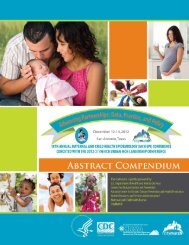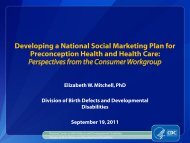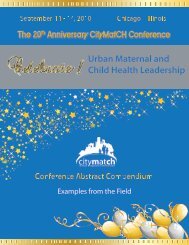Conference Abstract Compendium Examples from the ... - CityMatCH
Conference Abstract Compendium Examples from the ... - CityMatCH
Conference Abstract Compendium Examples from the ... - CityMatCH
Create successful ePaper yourself
Turn your PDF publications into a flip-book with our unique Google optimized e-Paper software.
2009 <strong>CityMatCH</strong> Urban MCH Leadership <strong>Conference</strong>Giving voice to African American women in shaping health disparity inquiryPRIMARY CONTACT:Pamela McGranahan, RN, MSNPrevention CoordinatorPublic Health Madison Dane County220 South Martin Lu<strong>the</strong>r King Jr. BlvdMadison, WI, 53704Phone: (608) 243-0425Fax: (608) 243-0425Email:pmcgranahan@publichealthmdc.comCATEGORYInfant mortality and morbidityRacial and ethnic health disparitiesFOCUSData FocusBACKGROUNDCO-PRESENTER(S)/AUTHOR(S):Suzanne Gaulocher, gaulocher@wisc.edu(Author, Presenter)In Wisconsin, infants born to African-American women are three to four times more likely to die before<strong>the</strong>ir first birthday than infants born to white women. Around 2002, African American infant mortalitydeclined dramatically and achieved rates comparable with Whites in <strong>the</strong> City of Madison and DaneCounty. Public Health-Madison & Dane County (PHMDC) is a partner in a larger collaborative researchproject to better understand this phenomenon.OBJECTIVESOur goal is to give voice to African-American women and community members in order to generatehypo<strong>the</strong>ses that will shape research involving African American infant mortality. We hope to illuminate<strong>the</strong> experiences and perceptions of African-American women, and to identify community-level factors orvariations in healthcare practices that might account for <strong>the</strong> apparent improvement.METHODSAs a preliminary effort, PHMDC conducted two focus groups made up of African American women. Thefirst group included eight women who had some historical perspective of childbearing in Madison andDane County prior to <strong>the</strong> year 2000. All participants in <strong>the</strong> second group experienced <strong>the</strong>ir pregnanciesand gave birth after 2002. Participants were asked about <strong>the</strong>ir life course as well as experiences withhealthcare, family, community, and <strong>the</strong>ir perceptions of race and racism. Additionally, 22 individualinterviews were conducted with providers, community members and African-American women to fill ingaps and pursue <strong>the</strong>mes suggested by <strong>the</strong> focus groups. All activities were filmed.58







